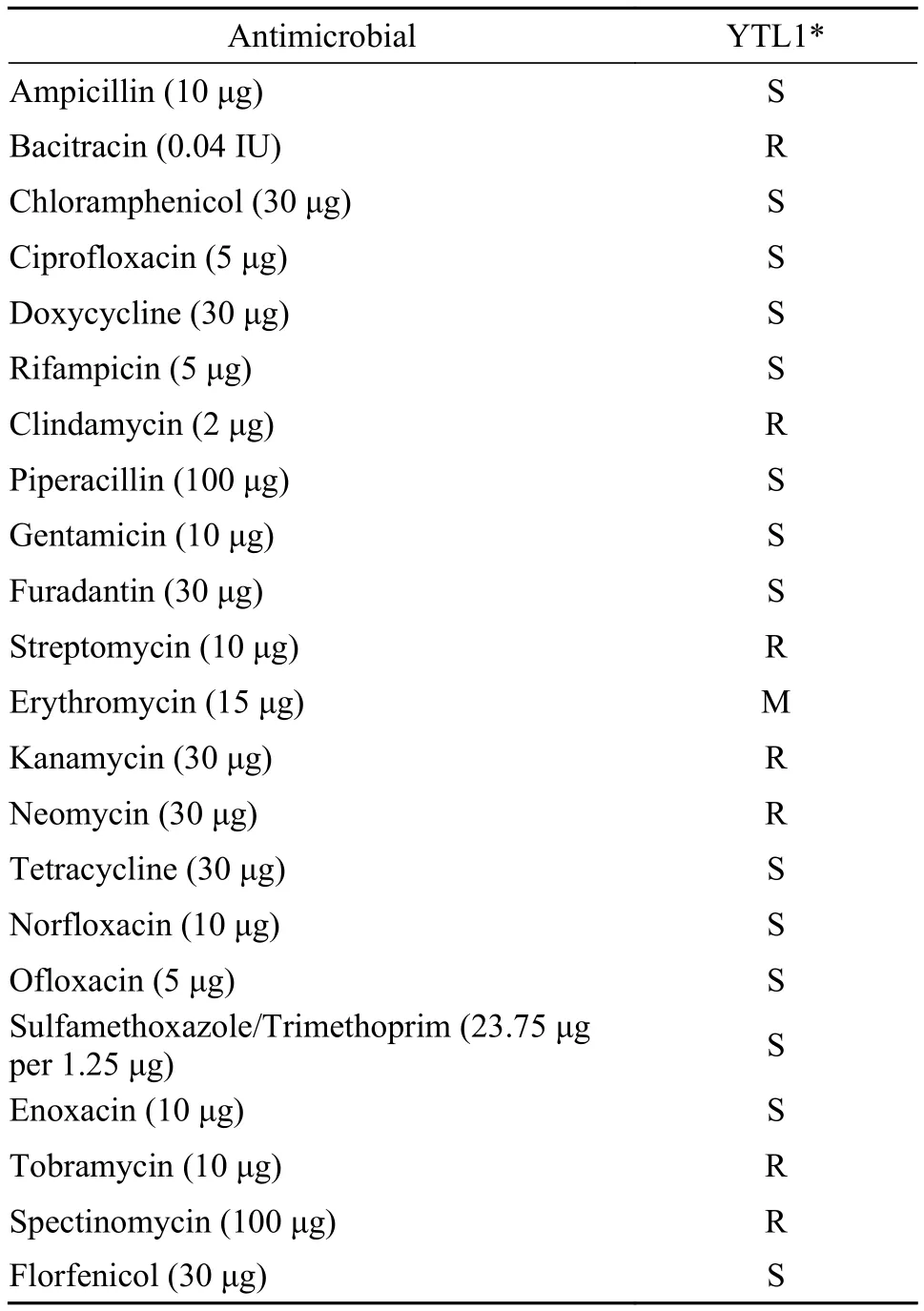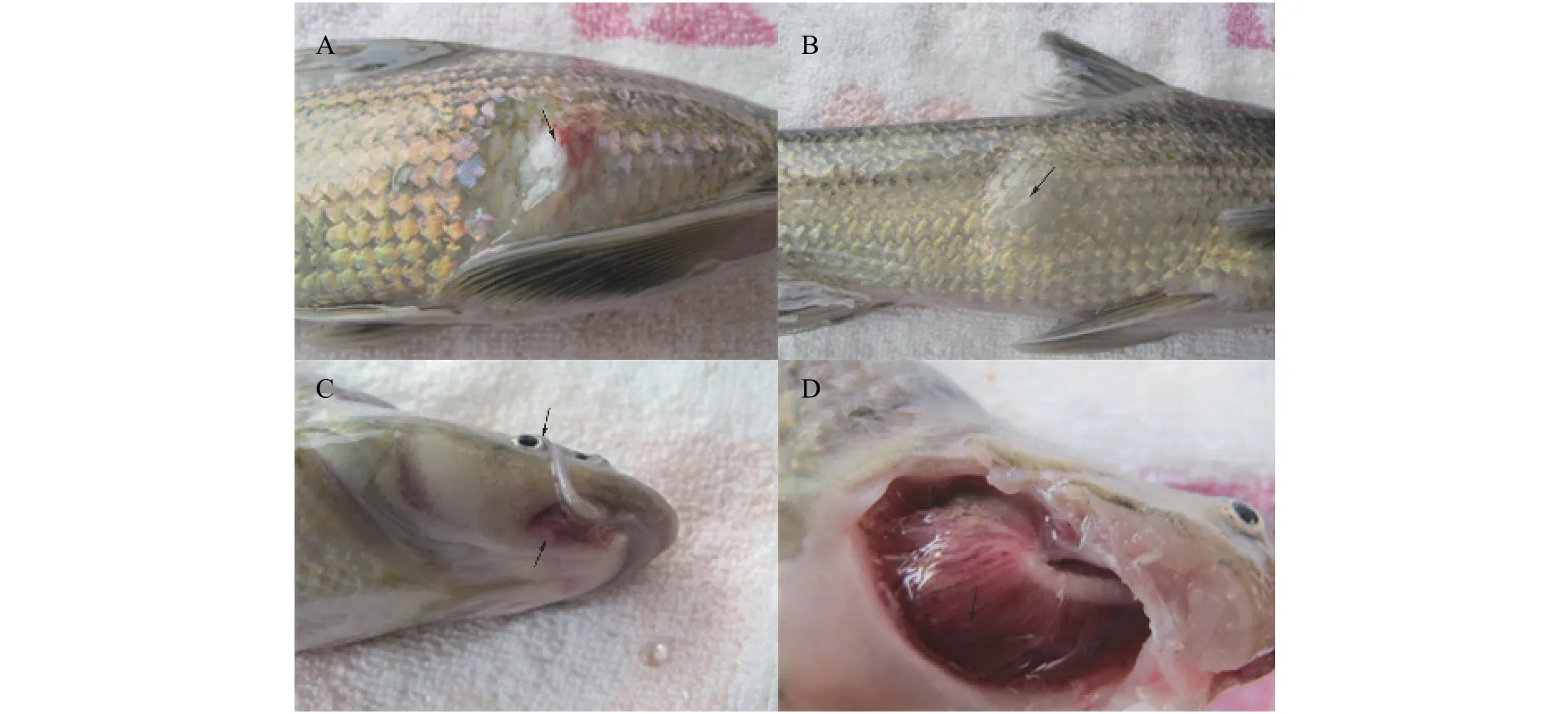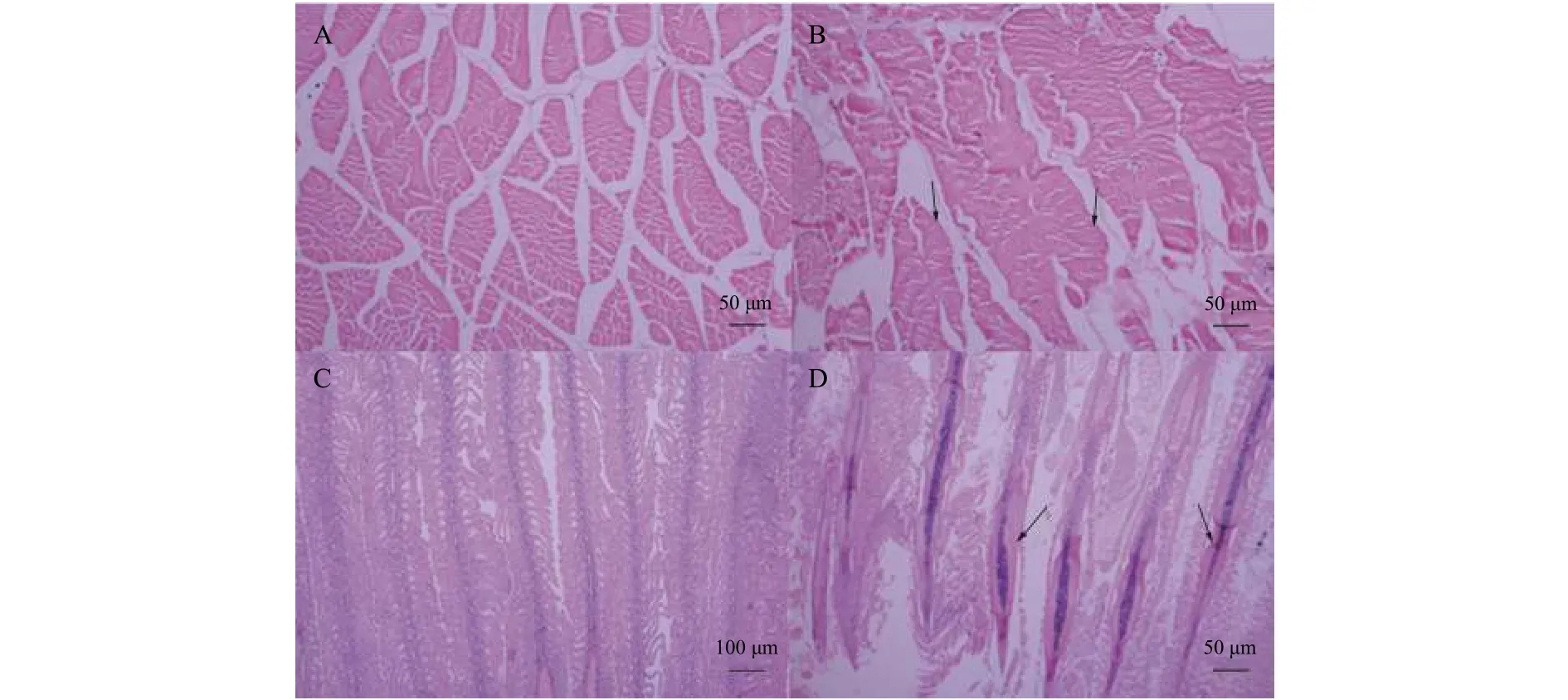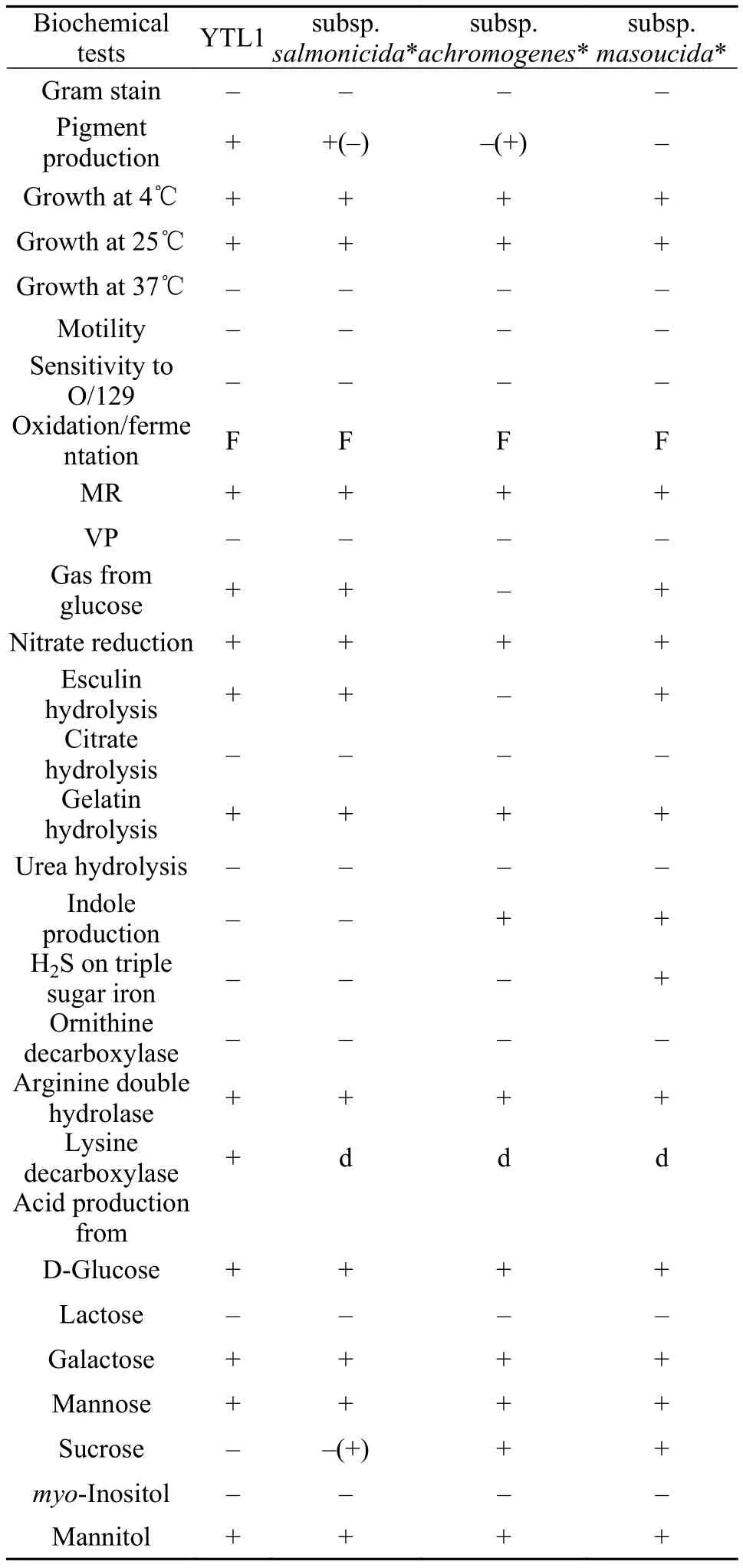ISOLATION AND CHARACTERIZATION OF AEROMONAS SALMONICIDA SUBSPECIES SALMONICIDA FROM LARGEMOUTH BRONZE GUDGEON(COREIUS GUICHENOTI) CAGE-CULTURED IN THE UPPER REACHES OF YANGTZE RIVER
LONG Meng , LI Tong-Tong, JIANG Yao ZHANG Qian-Qian ZHANG De-Feng, ZHANG Fu-TieWANG Jian-Wei and LI Ai-Hua
(1. Institute of Hydrobiology, Chinese Academy of Sciences, Wuhan 430072, China; 2. Shenzhen Institute of Guangdong Ocean University, Shenzhen 518108, China; 3. College of Biotechnology and Bioengineering, Zhejiang University of
Technology, Hangzhou 310014, China; 4. Pearl River Fisheries Research Institute, Chinese Academy of Fishery Sciences, Guangzhou 510380, China)
Abstract: Largemouth bronze gudgeon (Coreius guichenoti) is a potamodromous and endemic fish in the upper reaches of Yangtze River. An epidemic was found in largemouth bronze gudgeon at a farm in Luzhou,Sichuan province, southwest China, at the end of March 2012. In this study, we reported the first observation of furunculosis found in largemouth bronze gudgeon. One dominant bacteria strain, YTL1, was isolated from the liver of diseased largemouth bronze gudgeon, and a series of methods including morphological observation, biochemical tests, and phylogenetic analysis of 16S rRNA and six housekeeping genes were used to identify the pathogen. The strain was finally identified as A. salmonicida subsp. salmonicida based on the results. Antimicrobial susceptibility tests were carried out by the standard Kirby-Bauer disc diffusion method to screen effective drugs for the therapy of the disease, with results showing that YTL1 was sensitive to thirteen antibiotics such as florfenicol, norfloxacin, and ampicillin, resistant to 6 antibiotics such as bacitracin, streptomycin, and kanamycin, and mid-sensitive to erythromycin. Accordingly, florfenicol was added into diets to control furunculosis in largemouth bronze gudgeon with a good result. Artificial infection experiments in grass carp fingerlings and zebrafish resulted in the similar symptoms as diseased largemouth bronze gudgeon.In conclusion, our study demonstrated that multilocus sequence typing based on six housekeeping genes is an effective method to identify A. salmonicida strains to the subspecies level, confirmed that A. salmonicida infection is one of the greatest threats to artificial breeding and aquaculture of largemouth bronze gudgeon, and has expanded the susceptible hosts of A. salmonicida subsp. salmonicida to more cyprinid fishes.
Key words: Aeromonas salmonicida subspecies salmonicida; MLST; Furunculosis; Infection; Largemouth bronze gudgeon
Aeromonas salmonicidais the causative agent of furunculosis in salmonids and related diseases in other fish species[1].A. salmonicidahave been recovered from more than 20 cultured and 30 wild marine and freshwater fish species[2], and there are increasing reports of outbreaks in nonsalmonids such as common dab (Limanda limanda)[3], goldfish (Carassius auratus)[4],Scophthalmus maximus[5], sablefish (Anoplopoma fimbria)[6], snakehead (Ophicephalus Argus)[7],Yangtze finless porpoise (Neophocaena asiaeorientalis)[8]and so on.
Largemouth bronze gudgeon (Coreius guiche-notiSauvageetDabry 1874), belonging to Cyprinidae in the Cypriniformes, is one of the endemic fishes and an important economic fish distributed only in the middle and upper reaches of Yangtze River[9]. The artificial breeding and aquaculture of this species began in 2005 for commercial purpose and for supplying the natural population[9]. However, disease problems have emerged with the destruction of living environments and the development of the intensive culture. To date,few reports have been reported on largemouth bronze gudgeon diseases, three pathogens are known to be reported, includingIchthyophthirius multifiliis[10],Pseudomonas fluorescens[11], andLernaea polymorpha[12]. To our knowledge, although there was a report on the gut microbiome alterations of largemouth bronze gudgeon infected byA. salmonicidaby our laboratory[13], no systemic study on isolation and characterization ofA. salmonicidasubsp.salmonicidafrom largemouth bronze gudgeon has been reported yet.
In the present study, we conducted systematic researching aiming to identify and characterize the pathogen that caused the outbreak of cage-cultured largemouth bronze gudgeon in upper reaches of Yangtze River in Luzhou, China. A series of traditional identification tests, as well as specific molecular methods, were used to identify the pathogenic bacteria to species, and even subspecies level. The pathogenicity of isolated strain was verified according to the artificial infection experiments, and antimicrobial susceptibility tests were performed to guide treatments of the disease effectively.
1 Materials and methods
1.1 Diseased largemouth bronze gudgeon
From the end of March to April 2012, a severe outbreak occurred in a farm of cage-cultured largemouth bronze gudgeon in the upper reaches of Yangtze River, in Luzhou, Sichuan province, southwest China. Five fish showing typical clinical signs were collected from the farm and sent to our laboratory in ice boxes within a day.
1.2 Bacteria isolation and histopathological analysis
Using aseptic techniques, samples taken from liver, spleen, and ulceration of the diseased fish were streaked on Tryptic Soy Agar (TSA) plates and incubated at 20℃ for 24—48h. Single colonies were selected and re-streaked on the same media. Colony morphology was observed directly and by light microscopy. Cell morphology and cell mobility were examined as described previously[14,15]. All purified colonies were maintained separately in Tryptic Soy Broth (TSB) with 15% glycerol at -80℃. One strain YTL1 was selected as the representative strain.
Samples of tissue with gross clinical abnormalities were fixed in 10% buffered formalin. The fixed samples were then embedded within paraffin, stained with hematoxylin and eosin[16]and observed under a light microscope.
1.3 Biochemical analysis
Before being tested, YTL1 was sub-cultured twice overnight in TSB at 20℃. Gram staining, oxidation/fermentation (O/F) reaction, reduction of nitrate and indole, and hydrogen sulfide (H2S) production were investigated using conventional methods.Catalase activity was determined by transferring fresh colonies from TSA to a drop of 5% (v/v) H2O2in slide glass. Oxidase activity was determined using 1%(w/v) dimethyl ρ-phenylenediamine chloride. Motility was detected by the appearance of stab cultures in soft agar[17]. The growth of the strain at different temperatures was tested in TSB after incubation at 4℃,25℃ and 37℃ at least for 15d. Hydrolysis of esculin,gelatine and urea were detected by the methods described previously[18]. Acid formation from carbohydrates was tested by the method of Liu,et al.[19].
1.4 Antimicrobial susceptibility testing
The susceptibility pattern of YTL1 to 25 antimicrobial agents, which were purchased from Hangzhou microbial reagent Co., Ltd. (see detailed in Tab. 1),were tested in triplicate and determined using the standard method of Kirby-Baue[20]on Mueller-Hinton(MH, BD, USA) agar and incubated for 24h at 20℃.Escherichia coliATCC25922 was employed as a quality control strain[21]. Results were interpreted as susceptible, medium susceptible or resistant based on zone diameters of inhibition, including the diameter of the disc (mm)[22].
1.5 16S rRNA and Multilocus sequence typing analyses
Genomic DNA of YTL1 was extracted using Silica gel film Genomic DNA extraction kit (Omega,USA) according to the manufacture’s protocol. DNA was stored at -20℃ until use. A pair of universal primers, U8f: 5′-AGAGTTGATCATGGCTCAG-3′and U1492r: 5′-GGTTCACTTGTTACGACTT-3′[23]were used to amplify the 16S rRNA gene. The amplification, purification, sequencing, and BLAST of 16S rRNA of YTL1 were performed according to processes described previously[19,24]. Previously published sequences of related organisms were obtained from GenBank, and the phylogenetic tree was constructed using the neighbor-joining method[25]with the MEGA 4.1 program[26]through 1000-replicate bootstrap analysis.
Multilocus sequence typing (MLST) has been demonstrated to a powerful tool for outbreak traceability and phylogenetic distribution ofAeromonasstrains[27]. Six housekeeping genes (gyrB,groL,gltA,metG,ppsA,recA) were chosen for the MLST analysis, and the primers used for PCR amplification and sequencing were designed as Martino,et al.[27]. The reaction ran as followings: an initial step at 94℃ for 2min,followed by 35 cycles each of denaturation at 94℃for 1min, annealing at changing temperatures (i.e., the temperature changed from 65℃ to 60℃ in 0.5℃decrements during the first 10 cycles) for 30s, and extension at 72℃ for 2min. Allele sequences that differed from each other were attributed to a unique allele number in the order of discovery. Each unique allelic profile was assigned a sequence type (ST)number, and the same ST was used for some strains which shared the same allelic profile. The ST numbers of the eighteen isolates were obtained by visiting a website (http://pubmlst.org/aeromonas/). Multiple alignments containing the concatenated sequences were straightforward and performed according to the genomic gene order,gyrB,groL,gltA,metG,ppsA,andrecA. All analyzed MLST sequences had the same length (3084 bp). Concatenated sequences were aligned and the phylogenetic tree was constructed by using MEGA 4.1.

Tab. 1 Antimicrobial susceptibility test results of YTL1 isolated from diseased largemouth bronze gudgeon
1.6 Artificial infection experiments
Because it is very difficult to culture largemouth bronze gudgeon under indoor experimental conditions healthily, grass carp fingerlings and zebrafish were used to do artificial challenge assay. The mean weight of experimental grass carp fingerlings and healthy zebrafish were (15.0±2.0) g and (1.0±0.2) g,respectively. Assays of grass carp were conducted in 100 L aquaria with 50 L static water with aeration and for zebrafish in 10 L aquaria with 5 L static water,both were reared at the temperature of 20℃ for 15d prior to challenge. Half the water was exchanged once a day.
For artificial infection, fish were divided into four groups (10 fish each for grass carp and 20 for zebrafish, each group in triplicate) and challenged by intraperitoneal injection. YTL1 was cultured in TSA agar at 20℃ overnight and suspended in PBS buffer at three different doses (7.6 × 108, 7.6 × 107and 7.6 ×106CFU/mL), 0.2 mL was injected into each grass carp, and 0.05 mL into each zebrafish and sterile PBS was used for the control group. Clinical signs and mortalities were recorded every day for 15d postchallenge. LD50 was calculated using probability unit method[28].
2 Results
2.1 Characterization of diseased largemouth bronze gudgeon
The cumulative mortality was about 42% with a water temperature of (20 ± 1)℃ during the epidemic outbreak. The diseased fish were 18—20 cm in length. The major symptoms of the diseased fish were hemorrhage and swellings on the dorsal muscle, accompanying with shallow ulcerations and liquefaction of the muscle, red and swollen mouth, slight exophthalmia, and congestion in gills (Fig. 1).
2.2 Morphologic and Histopathology results
The colonies were short rod-shaped with particular brown diffusible pigment on TSA plates, singly occurring in pairs or chains with a diameter of 0.6—1.2 μm.
Microscopical examination of stained tissue sections from infected largemouth bronze gudgeon demonstrated the degradation and deformation of subdermal musculature, and severe congestion in gills.As Fig. 2 shows, the muscle cells shrank and deformed with the edges becoming blurred, and the gill septum exhibited congestion at the end (Fig. 2).
2.3 Biochemical characteristics
The biochemical characteristics of YTL1 were compared with threeA. salmonicidasubspecies: subsp.salmonicida, subsp.achromogenesand subsp.masoucida[29], and the results are listed in Tab. 2. Biochemical characteristics of YTL1 were more like those ofA. salmonicidasubsp.salmonicida. It was Gram-negative, non-motile, fermentative and resistant to the vibriostatic compound O/129. Growth was observed at 4, 25℃ but not at 37℃. There was gas produced from glucose. It was positive for MR, nitrate reduction, hydrolysis of esculin and gelatin, arginine double hydrolase and lysine decarboxylase and negative for VP, hydrolysis of citrate and urea, production of indole, H2S or ornithine decarboxylase. It produced acid from D-glucose, galactose, mannose,and mannitol but not from lactose, sucrose, and myoinositol.

Fig. 1 Characteristics of diseased largemouth bronze gudgeon, including (A) hemorrhage and liquefaction or (B) swollen of dorsal muscle,(C) red, swollen mouth and slight exophthalmia, (D) congestion in the gill

Fig. 2 Microscope images of stained section of the subdermal musculature of (A) an uninfected largemouth bronze gudgeon and (B) a largemouth bronze gudgeon infected with A. salmonicida with the muscle cells shrinking, deforming and the edges becoming blurred. Stained section of the gill from (C) a uninfected largemouth bronze gudgeon and (D) a largemouth bronze gudgeon infected with A. salmonicida with congestion at the end of the gill septum
2.4 Antimicrobial susceptibility results
As shown in Tab. 2, YTL1 was sensitive to ciprofloxacin, florfenicol, norfloxacin, piperacillin,chloramphenicol, sulfamethoxazole/ trimethoprim,ampicillin, tetracycline, doxycycline, furadantin, rifampicin, gentamicin, ofloxacin, enoxacin, with sensitivity from high to low; resistant to bacitracin, clindamycin, streptomycin, kanamycin, neomycin, spectinomycin, tobramycin; and mid-sensitive to erythromycin. As ciprofloxacin is a forbidden fishery drug, florfenicol was suggested to be added into diets (20—25 mg florfenicol per kilogram fish) to control furunculosis in largemouth bronze gudgeon for three consecutive days. Two weeks later, the mortality in the farm decreased and the epizootic was controlled.

Tab. 2 Biochemical characteristics of YTL1 and three reference Aeromonas salmonicida subspecies
2.5 16S rRNA and MLST analysis results
The nucleotide sequence of 16S rRNA of YTL1 was determined and the GeneBank accession number was KC254647. A phylogenetic tree on the basis of 16S rRNA sequences of YTL1 and twenty type strains of the genusAeromonaswas constructed and shown in Fig. 3A. From the phylogenetic tree, we can see that YTL1 formed a cluster withA. salmonicidaspecies.
The GenBank accession numbers of the six housekeeping gene sequences of YTL1 were as follows:gyrB(KC528650),groL(KC528668),gltA(KC528686),metG(KC528704),ppsA(KC528722),recA(KC528740). YTL1 had an ST number of 2. A phylogenetic tree was constructed based on the 3084 bp concatenated sequences of the six loci of YTL1 and eighteen type strains of genusAeromonas. The origins and typing data of thoseAeromonastype strains were described as Martino,et al.[27]. In the phylogenetic tree, YTL1 formed a single cluster withA. salmonicidasubsp.salmonicidaNCIMB 1102 (Fig. 3B).
2.6 Artificial infection result
YTL1 was demonstrated to be pathogenic to both grass carp fingerings and zebrafish, and infected grass carp and zebrafish showed the same clinical signs such as swellings and ulcerations in the dorsal muscle, a few blood clot in the back and a reddened and swollen anus, which were identical to the symptoms of diseased largemouth bronze gudgeon. Pure cultures ofA. salmonicidasubsp.salmonicidawere re-isolated from ulceration, liver, and kidney of moribund grass carp and zebrafish after challenge.Mortality of grass carp was 40%, 70% and 100% with the low, medium and high doses, respectively, and LD50 was 1.6 × 107CFU/mL. While, mortality of zebrafish was 75%, 90% and 100% with the low, medium and high doses, respectively, and LD50 was 1.4 ×106CFU/mL. No control fish developed clinical signs or died.
3 Discussion
In the present study, we carried out the isolation,identification and molecular characterization ofA.salmonicidasubsp.salmonicida, for the first time, in farmed largemouth bronze gudgeon in China.
A. salmonicidais a well-known fish pathogen and five subspecies ofA. salmonicidahave been described so far: ssp.salmonicida, ssp.achromogenes,ssp.masoucida, ssp.smithia, and ssp.pectinolytica[30,31].For many years, it was believed thatA. salmonicidawas restricted to salmonids, but over recent years, the range of reported hosts has been enlarged, and nowA.salmonicidahas been reported from at least 58 species[2,32,33].A. salmonicidassp.salmonicida, the causative agent of furunculosis in salmonids, is referred to as typical, whereas the other strains are referred to as a typicalA. salmonicida, which has been isolated from a wide range of cultured and wild fish species,non-salmonids as well as salmonids, inhabiting freshwater, brackish water, and marine environments[34—36].In this study, YTL1 was identified asA. salmonicidassp.salmonicidaaccording to biochemical and biophysical characteristics and molecular analyses. Based on our finding, we estimate thatA. salmonicidassp.salmonicidais not special to salmonids, and non-salmonids could also be infected with it. Then a question needs to be thought and solved in the future is that are the typical and atypical still applicable to the taxonomy ofA. salmonicida?
Largemouth bronze gudgeon is a benthic and potamodromous fish that is typically found in rivers with torrential flow, and its habitat behaviors have been reported to be similar to salmonids[9], which has a complex life history, with populations of migratory,non-migratory (resident), and a mixture of the two[37—39]. This is an important common feature that largemouth bronze gudgeon and salmonids have, and the reasons why largemouth bronze gudgeon can be infected byA. salmonicidasubsp.salmonicida(which is thought to be special to salmonids) might be sourced from it. In addition, it has been reported that the optimal growth temperature forA. salmonicidawas 20—25℃[40], while water temperature of the diseased largemouth bronze gudgeon was 20℃, so the temperature could also be considered as a factor that caused this epizootic.
It has been reported that the biochemical identification ofA. salmonicidacan be done to species level[2]. In the present study, using morphological and biochemical assays, YTL1 was shown to be gramnegative, positive pigment production and oxidase reaction,etc., based on which it was identified toA. salmonicidaspecies, with more similarity toA. salmonicidasubsp.salmonicida. In order to verify the results and identify the strain to subspecies level, we used molecular methods, including the amplification and sequencing of 16S rRNA and six housekeeping genes.In the past decades, 16S rRNA sequencing has emerged as the most powerful method for elucidating bacterial phylogeny[41]and was discerned to have possible value for differentiating mostAeromonasspecies[42]. According to 16S rRNA gene sequence and phylogenic analyses, YTL1 had 16S rRNA gene sequence with 99% similarity to those of the validatedA. salmonicidaspecies and clustered withA. salmonicidastrains, which further demonstrated that YTL1 belonged to species ofA. salmonicida. As MLST based on six housekeeping genes (gyrB,groL,gltA,metG,ppsA,andrecA) has proven to be a useful tool for inferring the taxonomy of the genusAeromonas[27,43],in this study, the result of MLST identified YTL1 to the subspecies level as YTL1 formed a single cluster withA. salmonicidasubsp.salmonicidaNCIMB 1102. Thus MLST could be suggested to act as an effective and rapid way to identifyA. salmonicidastrains to subspecies level in the related researches.
The artificial infection experiments using grass carp fingerlings and zebrafish clearly demonstrated the pathogenic potential of YTL1 and confirmed the bacteria as the aetiological agent of this epizootic in cultured largemouth bronze gudgeon. Because the culture of largemouth bronze gudgeon can mostly be performed in net cage near the shore in the upper reaches of the Yangtze River from Luzhou to Hejiang,and no studies have reported on the successful indoor culture of largemouth bronze gudgeon[44]. We chose grass carp fingerlings and zebrafish (model fish) in this study to test and verify the pathogenicity of YTL1. Test results revealed that both grass carp fingerlings and zebrafish were susceptible to this bacteria strain, and the infected fish showed the same symptoms as diseased largemouth bronze gudgeon,which strongly demonstrated that it wasA. salmonicidasubsp.salmonicidacausing the outbreak. At the same time, according to the infection experiments, the susceptible hosts ofA. salmonicidahave been expanded to include grass carp and zebrafish, which have never been reported to be infected byA. salmonicida,reminding us to do well preventive work during daily farming of these fishes. Furthermore, largemouth bronze gudgeon, grass carp fingerlings, and zebrafish all belong toCyprinidaein theCypriniformes, so a hypothesis could be estimated is that YTL1 orA. salmonicidamay be an important potential pathogen to cyprinid fish, and can infect them when conditions and environments are right or suitable, however, more findings and studies ofA. salmonicidainfection in other cyprinid fish are needed in future to verify it.
The farm epizootic lasted about one month with the severe loss of up to ~42% fish. Following the antibiotic susceptibility test, the infected fish were treated by oral administration of florfenicol, and after 2 weeks, the mortality ceased. But to prevent and control the disease more effectively and avoid the use of antibiotics, an appropriate vaccine is needed, which is our next research object. Although some studies have already been done onA. salmonicidavaccines[45,46],there is still a long way to go to develop more effective, economical, and practical vaccines.
In conclusion, this is the first report ofA. salmonicidasubsp.salmonicidaisolated from non-salmonids fish, largemouth bronze gudgeon. We consider this study of important value for further investigations ofA. salmonicidaepidemiology and taxonomy as well as valuable clinical significance.

